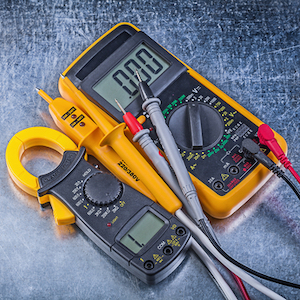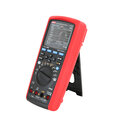Clamp Meter vs Multimeter

Figure 1: A clamp meter (left) and a multimeter (right)
Clamp meters and multimeters are both tools for measuring current in a conductor, but they differ in their measurement techniques and applications. A clamp meter measures current by clamping around a conductor, while a multimeter measures current by breaking the circuit and placing the instrument in series with the conductor. The choice between the two depends on the specific needs of the user, including the application, accuracy required, and level of safety needed.
- A multimeter is the best option if various electrical tests (i.e. resistance and voltage tests) need to be carried out and highly accurate results are necessary. If the purpose is to test currents across the property, a clamp meter is better.
- If safety is the primary concern while performing a current measurement, it is advisable to use a clamp meter.
View our online selection of clamp meters and multimeters!
What are clamp meters and multimeters?
Clamp meters and multimeters both measure electrical parameters. A clamp meter measures current without interrupting the circuit, making this tool ideal for taking measurements in tight spaces or testing live wires. Multimeters can measure current, voltage, and resistance and are more accurate than clamp meters. Learn more about each tool by reading our clamp meter and multimeter overview articles.

Figure 2: Taking measurement using a higher-end clamp meter that measures using jaws and a lead (left). Taking measurements using a multimeter (right).
Comparison between clamp meters and multimeters
Table 1: Clamp meter vs multimeter
| Clamp meter | Multimeter | |
| Measurement parameters |
|
|
| Mode of measurement |
|
|
| Accuracy and resolution |
|
|
| Safety and ease of use |
|
|
| Applications |
|
|







